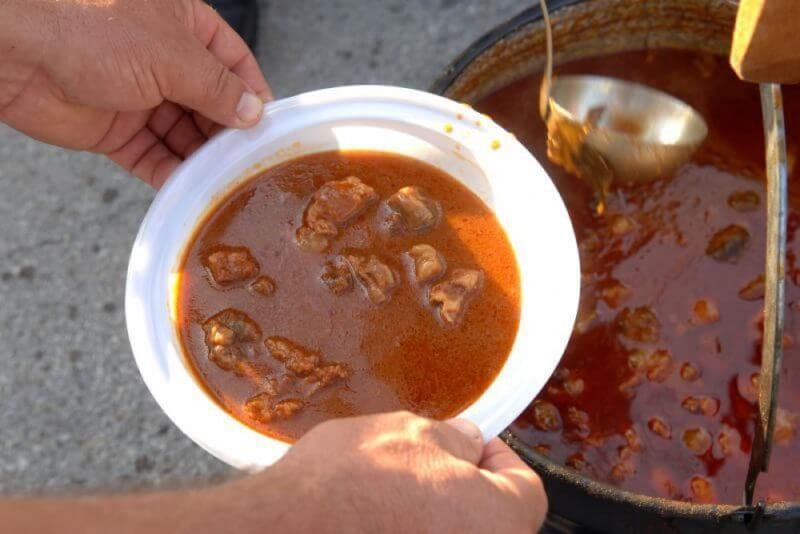As every country that is culturally, historically and geographically as diverse as Croatia, its cuisine can hardly be pinpointed to only one type. Over the course of time and the historical impact of other nations, a wide range of now-called traditional Croatian dishes developed in different parts of the country.
The continental cuisine of Croatia for example, under the influence of Austrian and Hungarian hegemony, is mostly based on meat dishes and vegetables that are often served in rich and spicy sauces.
The traditional coastal cuisine is, on the other hand, mostly based on seafood, domestic olive oil and vegetables like chard. Inevitable condiments that give this Croatian food its unforgettable taste are rosemary, basil and other Mediterranean herbs. Dalmatian and Istrian dishes are not only light and healthy, but also extremely delicious. Although sometimes similar to the cuisine of neighboring Mediterranean countries, the coastal cuisine of Croatia has many dishes that are unique only to this geographical region.
So, what do Croatians eat? Whether you are travelling in the continental or coastal part of Croatia, here are our top Croatian food dishes you should definitely try while being in our beautiful country.
Continental Croatian food
The capital Zagreb, but also other regions in the continental part of Croatia, attract more and more visitors every year and while exploring these areas, we highly recommend trying some of the delicious and hearty dishes they are famous for.
Roast turkey with homemade mlinci
If you are by any chance invited for Sunday lunch by a Croatian family in Zagreb, this is most probably what you will be served. The turkey, which is slowly roasted in the oven for several hours, is widely well-known, but it’s the side dish mlinci that makes it a unique traditional Croatian dish.
Mlinci are made of dried thin flatbread that is broken into small pieces and stirred into the rich roasting sauce where they soak up the juices and fat. Together with the tender turkey they create a fabulous and delicious meal you will surely enjoy.
Čobanac
This Croatian food from Slavonia is certainly a must for all meat lovers. The stew was invented by shepherds in the Slavonian plains to keep them strong and warm all day. It consists of various types of meat (beef, pork, lamb or game), lots of onions and other vegetables and a generous amount of sweet and hot, red pepper.
The secret lies in the preparation time as the stew must simmer for hours to develop the hearty aroma and should then be consumed in good company with some excellent regional white wine.
Kotlovina
Kotlovina is another famous meat stew that developed in the northern regions of Croatia. As it is usually cooked outdoors above an open fire and on special occasions, Kotlovina became a synonym for a large group of people that are having a great time together. The stew can be prepared with different types of meat, though pork meat (including sausages, chops and spare ribs) is the most popular one.
The marinated meat is first fried in a large metal cauldron (Croatian called “kotao”) and then placed on the side. While the meat is kept warm at the brim of the cauldron, all other ingredients (onions, peppers, potatoes and spices) are slowly cooked in the juice of the grilled meat and a copious amount of white wine. Once the vegetables are done, the meat is placed back into the dish and served as a hearty stew with bread and wine.
Sarma
Sarma are basically small sauerkraut rolls that are filled with minced meat and rice and slowly cooked in a red sauce made of onions, red pepper and tomatoes. This popular winter meal is widely known and loved all over the Balkan region and the question of its origin is still not resolved as many countries claim it as their own.
Well, regardless of where it came from and who made it first, sarma is a yummy meal that can be tried not only in the continental part of Croatia, but also at the coast.
Stuffed bell peppers
Punjene paprika, as the Croatians call it, is the lighter summer version of sarma. The ingredients and preparation procedure are more or less the same. The main difference is that green bell peppers are used instead of sauerkraut and the sauce has a richer tomato flavor.
This delicious dish is usually prepared in large quantities, so it can be eaten over several days. You can often find it on the daily menus of restaurants where there are served with mashed potatoes for a good price. As it is popular throughout Croatia you should taste this Croatian food wherever you are.
Zagorski štrukli
Another traditional dish in the northern parts of Croatia and particularly in Zagreb and its surroundings are štrukli. This popular pastry that is made of dough and various types of fillings can either be sweet or salty (depending on the filling) and cooked or baked.
Every housewife in the Zagorje region prepares štrukli according to her own recipe that has been passed on for generations. This delicacy can be consumed as a starter, main dish or dessert. Zagorski štrukli have been recognized for their cultural and traditional value and were placed on Croatia’s intangible cultural heritage list in 2007.
Coastal Croatian food
The 1.777 km long Croatian coast and its over 1.000 islands offer not only an abundance of beauty and intact nature, but also a gastronomic variety that lures gourmets from all over the world to this part of the Adriatic Sea. Fresh seafood is, of course, the number one ingredient! However, there are also some excellent meat dishes and sweets that should not be missed on your taste-the-best-list.
Black risotto
This fantastic and peculiar looking dish is for true seafood lovers and can be found all along the Croatian coast. The risotto has a strong flavor thanks to the cuttlefish or squid ink that gives it the unique dark color. Although the ingredients are simple and very common in the coastal cuisine- olive oil, garlic, parsley, white wine and pieces of cuttlefish (alternatively squid or octopus)- the preparation process is tricky and can be quite a mess as the ink sac has to be removed from the cuttlefish without bursting.
If you want to try it at home, beware that a white kitchen easily turns black in this cooking experiment! There is of course always the option to buy already cleaned cuttlefish at the fish markets.
Peka
If you are visiting the coast or the islands in Dalmatia and you are looking for a dish that is traditional and extremely tasty, then you should try peka. Depending on your preferences, you can go for the seafood version with octopus or the alternative with meat since the cooking process is the same.
Meat or seafood is placed along with potatoes and other vegetables in a round shaped baking tray and covered with a heavy bell-shaped metal lid. The tray is then placed on a wood burning fire and covered from all sides with embers, allowing the food inside to slowly cook until perfection. Beware that you must order peka several hours in advance at a restaurant and that it is usually served for a group of 3-5 people.
Pašticada
Pašticada is a beef stew with a long tradition in Dalmatia. The oldest known recipe was discovered in Dubrovnik and dates back to the 15th century. As it takes a lot of preparation time, it is usually served on festive occasions. The meat is larded with bacon, garlic, cloves and herbs and kept in a vinegar marinade overnight.
It is then braised for several hours in its own juice and, once the meat is really tender, prunes, figs, tomato puree and the sweet wine Prošek are added to give the meat its great aroma. Pašticada is served with homemade gnocchi and a dish we all love here in Dalmatia.
Fuži
Istria’s number one dish is the homemade pasta called fuži. This simple dish, in which the dough is hand-rolled and shaped into small cylindrical rolls, is served with various types of sauces and meat.
However, our favorite version of this traditional Istrian dish is with white truffles that are an exclusive delicacy of the region. Fuži taste especially good with the excellent local wines for which Istria is famous for.
Rožata
To complete a wonderful lunch or dinner in the coastal region, one should not miss out on this sweet delicacy from Dubrovnik. This custard based pudding that resembles crème brûlée gets its aromatic flavor from the rose liquor that is used in its preparation. What better way to end a beautiful meal than with this silky and light pudding that is served in a pool of yummy caramel sauce.
In the past years, Croatia has developed into a top holiday destination not only due to its natural beauty and astonishing history, but also because of the excellent Croatian food that has gained a world-wide reputation.
Despite the still large number of restaurants with grilled meat and pizza, there is an increasing trend of high-class restaurants that serve fantastic authentic dishes. The kitchen chefs recognized the wish of customers who were looking for local and traditional food and hence created menus that are based on regional products and often have a modern twist.
Other highly recommended places for those in search of good Croatian food are the widely spreading OPGs. OPGs are certified family run farms that are particularly present in Istria, the Dalmatian hinterland and on the islands. If you decide to visit one of these farms, you can be assured that you will taste organic grown vegetables and fruits and meat from free-ranging animals.
The local farmers successfully implement the concept from Farm-To-Table and have therefore become more and more popular over the past years. Their farms do not only offer a cuisine that is based on high quality products, but they are also usually located in a wonderful natural setting. By eating at these farms you will be able to experience delicious Croatian food and also support the local, rural communities and simple farmers who focus on sustainable and environmental-friendly agriculture.














 No products in the cart.
No products in the cart.